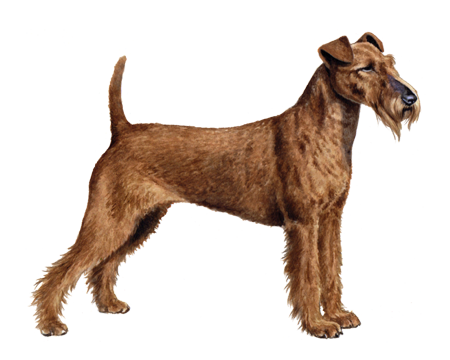
Giant Schnauzer
The Giant Schnauzer is responsive, alert, and independent. This larger, more powerful version of the Standard Schnauzer is highly intelligent and loyal to its people. Giant Schnauzers make ideal working dogs and family companions.
Interested in discovering if your dog is a Giant Schnauzer?
Check out Wisdom Panel's DNA tests.

Giant Schnauzer Traits
General Appearance
The Giant Schnauzer is a powerful dog that demonstrates strength in everything it does. A large, muscular, athletic body gives this breed a stately and dignified look.
Coat and Colouring
The Giant Schnauzer has a wiry outer coat with a close undercoat. The AKC standard recognizes only two colors: black and salt and pepper. Black and white banded hairs and solid black and white hairs make up the salt and pepper coat.
Distinctive Physical Traits
A strong blocky head, harsh beard and eyebrows, and an imposing build are stand-out traits of this powerful breed.
Giant Schnauzer Temperament
The Giant Schnauzer is good-natured but can be quite dominant. Typically friendly toward other dogs, Giant Schnauzers love to be around their families and children, making them ideal family pets.
Giant Schnauzers are very loyal, devoted, and protective of their people—good traits for a guard dog. They need lots of attention and companionship and plenty of participation in family activities to be happy. These pups want to be in on the action, not left alone in the house or yard.


Giant Schnauzer History
The Giant Schnauzer originated during the mid-1800s in Germany and the Bavarian Alps (including Bavaria and Wurtemberg). Cattle ranchers needed a bigger, more powerful breed that could effectively herd their cattle.
So breeders developed the Giant Schnauzer by crossing the smaller Standard Schnauzer with other breeds—including the Great Dane. The resulting breed excelled as a guard dog and cattle herder. And its tough coat protected it from the elements.
The breed came to the United States during the early 20th century and was used extensively in police and military work. The American Kennel Club has only recognized Giant Schnauzers for about 50 years—partly because the breed was rare and relatively unknown until the 1960s.
Giant Schnauzer Care
Nutrition
Giant Schnauzers need a high-quality diet that is age-appropriate—whether it's commercially manufactured or homemade (with a veterinarian's supervision and approval).
It's important to keep an eye on the amount of food you give your Giant Schnauzer and reduce the portions if your pup gains weight. Also, remember that giving too many treats in addition to regular meals can contribute to obesity.
Grooming
The Giant Schnauzer's thick and wiry double coat consists of a soft undercoat and rough outer coat. Weekly brushing and regular clipping/stripping are a must for this breed. Keeping their coats in tip-top shape takes a fair amount of time. And periodic trips to the groomer will help keep the breed looking its best.
Round out your grooming routine by checking your Giant Schnauzer's ears frequently for signs of infection. Brushing their teeth regularly with a dog-formulated toothpaste is also integral to their overall health.
Exercise
Giant Schnauzers have more energy than most big breeds and require a tremendous amount of exercise. They enjoy dog sports such as agility, tracking, herding, carting, rally, and competitive obedience. A long daily stroll, playdate with other dogs, and games in a fenced yard are also sufficient ways to satisfy your pup's mind and body.
Training
Giant Schnauzers are intelligent dogs. But they can be hard-headed. Lessen these stubborn tendencies by using reward-based training methods involving small treats and favorite toys. Training should be firm, consistent, and gentle—and start at an early age.
The Giant Schnauzer learns quickly and needs to have a job, even if it's as simple as chasing a ball. This breed is often reserved around strangers. But Early socialization can help prevent this behavior and reduce any defensive, aggressive tendencies.

Giant Schnauzer Genetic Health Conditions
-
Dilated Cardiomyopathy (Discovered in the Schnauzer)
Dilated cardiomyopathy (DCM) is a cardiac disorder causing heart failure.
-
Factor VII Deficiency
Factor VII Deficiency is an inherited blood clotting disorder that results in excessive bleeding occurring after a severe trauma or surgery. The signs of the disease are typically mild but can vary in severity in different affected dogs.
-
Fetal Onset Neuroaxonal Dystrophy
Fetal Onset Neuroaxonal Dystrophy (FNAD) is a disorder that disturbs the development of motor (movement) nerves in the central nervous system. Signs include abnormal curvature of the spine and contracted joints. Affected puppies to have no voluntary movement of limbs. Respiratory deficiencies (difficulties breathing) cause affected puppies to die at birth.
-
Hyperuricosuria
Hyperuricosuria (HUU) is a condition that predisposes affected dogs to the formation of urinary stones, such as kidney or bladder stones.
Knowing if your Giant Schnauzer is a carrier or at-risk for these conditions can help you and your veterinarian plan for your pup's lifelong care. With Wisdom Panel™ Premium, you can get results for over 200 genetic health tests.
Breed Group
Terrier
The Terrier Group ancestors were bred to hunt and kill vermin. They are often characterized as feisty and energetic dogs whose sizes range from fairly small to much larger.































































